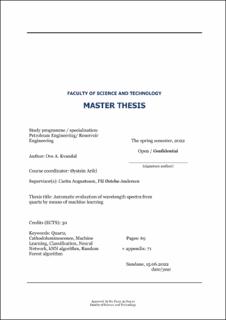| dc.description.abstract | I have for this thesis worked on automating the steps in evaluating wavelength spectra from
quartz. To do this I have applied different machine learning algorithms suitable to the automation requirement at each step, and they were implemented using Python.
A neural network is used to fit a curve to cathodoluminescence spectra from quartz. From this
curve are feature values extracted, which are then to be used by a machine learning classification algorithm to predict which of three defined groups a quartz sample belong to.
Two machine learning classification algorithms have been evaluated: The kNN algorithm and
the Random Forest algorithm. These algorithms were trained on multiple feature subsets derived from two different datasets. The difference between the two datasets is that one, the
reduced dataset, has had cathodoluminescence spectra influenced, primarily by feldspar, removed.
The classification algorithm whose model achieved the highest accuracy was the kNN algorithm with 84%. It achieved this when trained on a feature subset derived from the reduced
dataset where only features representing intensity were included. The best performing model
by the Random Forest algorithm achieved an accuracy of 81%. | |
